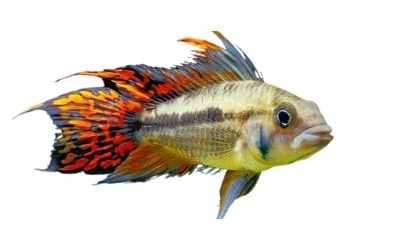The cockatoo cichlid is an exceptionally appealing fish because of its toughness and lovely tinge. It is a ray fined fish under Cichlidae family of order Perciformes. It (Apistogramma cacatuoides) was first exposed by the Dutch ichthyologist J. J. Hoedeman in 1951. It is not listed as threatened species on the IUCN Red Data Book.
Distribution and Habitat
It is local to River basin of Amazon, South America and its tributaries, Solimões streams, Pachitea River to Tabatinga of Peru and Colombia. It likes to live in little shallow streams or tidal pond where water base spreads with aquatic vegetation as concealing spots.
Common Names
It is called by various common names including Cockatoo Dwarf Cichlid, Big Mouth Apistogramma Crested Dwarf Cichlid, and Double Full Red Cockatoo Cichlid.
Body Shape and Colors
Body is lengthened with one parallel stripe that keeps running from the eye to the base of the caudal fin. The body has darker to dim hues however the belly is brilliant darker in shading. The dorsal fin is green with orange tipped while the anal fin has green periphery. Tail fin or caudal fin has green shading with heaps of red spot. Back parts of all fins have spiny rays while the front parts are soft. During the spawning season, the caudal fin of the female becomes more rounded and her colors become deep.

Size and Lifespan
Its life expectancy ranges from 5 to 10 years or more with appropriate care. The grown-up male is bigger that achieves a length of 10 cm while the female achieves just 5 cm.
Quick Cockatoo Cichlid Facts
Feeding Behavior
It is predatory fish and in nature, it basically feeds on benthic invertebrates, for example, tubifex, insect larvae, brine shrimp (Artemia) etc and so on. In aquarium condition, it takes live or frozen nourishments, for example, Artemia, Copepod, Chironomus hatchlings, flakes, pellets, tablets and finely slashed meat. To keep your fish sound and glad should be offered no less than 2 times daily.
Housing and Care Facts
The cockatoo cichlid is an exceptionally demanding fish among the aquarium aficionados because of its splendid body shading and peaceful behavior. It requires no less than 30 gallons tank or bigger with a lot of open zones and concealing spots. The tank base should have a rock to the sand substrate with aquarium plants like the Amazon Sword, Vallisneria, Anubias, and Wisteria. The tank should also have great water quality with an efficient filtration system. 20-25% water changes should be done at regular basis to make your tank condition healthy.
Tank-mates
This is a community fish that should be kept in groups of 6 to 8 individuals with other nonaggressive fish. Appropriate tank-mates incorporate Dwarf Rainbowfish, Julii Cory, Kuhli Loach, Glowlight Rasbora, Dwarf Gourami, Cardinal Tetras, Hatchetfish, Pencilfish, Otocinclus Catfish, and Loricarid fishes.
Breeding Behavior
Cockatoo Cichlid is an egg layer fish. It can easily breed in hostage condition with appropriate care. The breeding aquarium should have bogwood, upturned flowerpots, fake coconut caves and aquatic plants as spawning sites. The mature female can lay about 100 eggs. The hatching of eggs occurs within four days. The fry should be nourished with newly hatched nauplii and Artemia. In around five months, the fry achieves sexual development.
Male and Female Differences
Generally, the male is larger in size than the female of the same age. The male is overall brightly colored with first several dorsal fin rays are extended than the female. The belly and pelvic fins of the male are brilliant dark colored in shading while in female, pelvic fins bear a black edge. The female`s belly also bears dull yellow in shading.
See Also: White Cloud Mountain Minnow Fish Facts
Concluding Remarks
The cockatoo cichlid is a gorgeous aquarium fish among the aquarium enthusiasts. It has many color variations such as the full red, double red and triple red, super red and orange. We prescribe you to purchase this attractive fish to make your aquarium more appealing.
